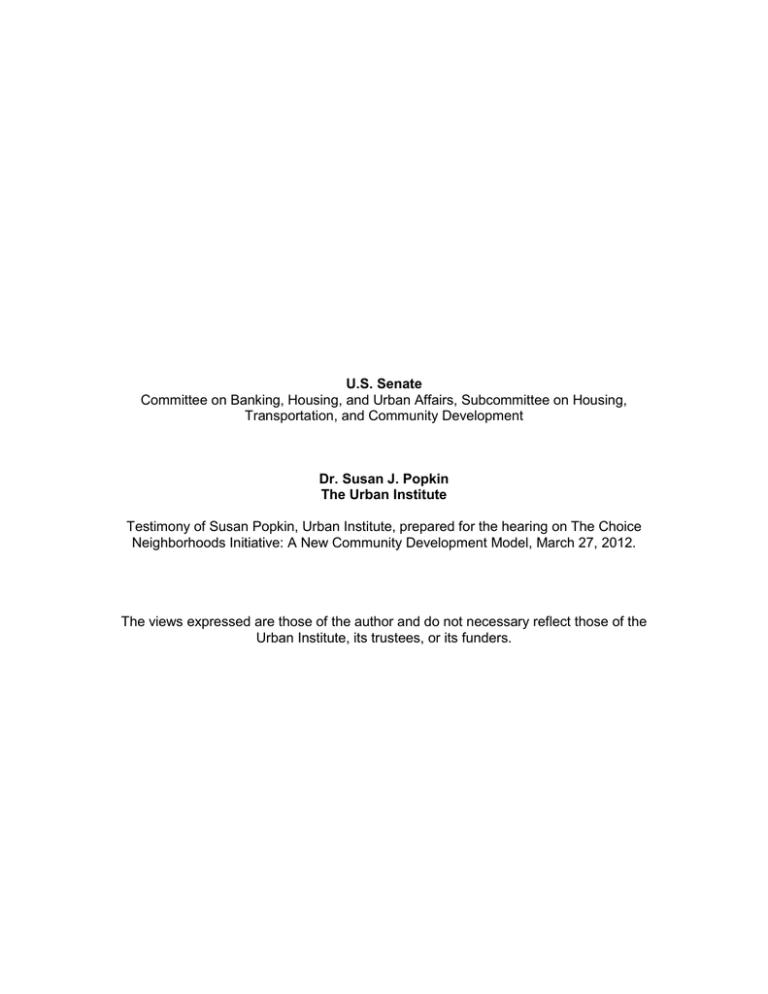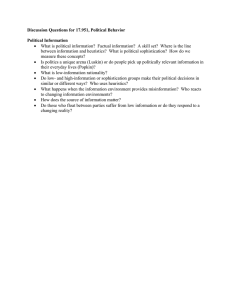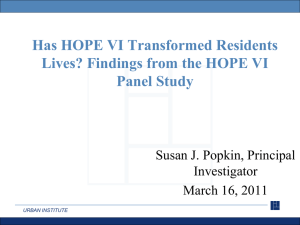Committee on Banking, Housing, and Urban Affairs, Subcommittee on Housing,
advertisement

U.S. Senate Committee on Banking, Housing, and Urban Affairs, Subcommittee on Housing, Transportation, and Community Development Dr. Susan J. Popkin The Urban Institute Testimony of Susan Popkin, Urban Institute, prepared for the hearing on The Choice Neighborhoods Initiative: A New Community Development Model, March 27, 2012. The views expressed are those of the author and do not necessary reflect those of the Urban Institute, its trustees, or its funders. Popkin Testimony The Choice Neighborhoods Initiative Mr. Chairman and members of the Committee, thank you for inviting me to appear here today. For the past 14 years, I have been studying the impact of the HOPE VI program on the original residents of public housing projects that are demolished and replaced. While most of my research has focused on Chicago, which had more distressed public housing than any other city in the country, I have conducted research in 13 HOPE VI sites across the country. The testimony I present here today draws from four major studies: The HOPE VI Panel Study, which tracked residents from five sites across the country; the Chicago Panel Study; the Chicago Family Case Management Demonstration; and the new HOST Demonstration. Twenty years ago, dilapidated, high-crime public housing developments populated by impoverished, female-headed households were a powerful symbol of the failures of U.S. social welfare policy. HOPE VI was a key element of a bold effort to transform these public housing communities and demonstrate that housing programs could produce good results for residents and communities. The program provided grants to housing authorities to replace their most distressed developments—those with high crime rates, physical decay, and obsolete structures—with new, mixed-income, mixedtenure communities. In a departure from earlier efforts to “rehabilitate” public housing, HOPE VI sought to move beyond “bricks and mortar, and provided funding for supportive services for residents intended to help them move toward self-sufficiency and improve their life circumstances” (Popkin, Levy, and Buron 2009). HOPE VI was, at its core, a housing intervention, and there is no question that the program has changed the face of public housing—hundreds of those dilapidated structures have been replaced with attractive new developments, and the program has sparked innovations in financing and management (Katz 2009; Popkin et al. 2004). The program succeeded in improving many families’ housing situations and quality of life. 1 Popkin Testimony The Choice Neighborhoods Initiative Evidence from The Urban Institute’s comprehensive HOPE VI Panel Study and its follow-up, the Chicago Panel Study, shows that many former residents received Housing Choice Vouchers or moved into mixed-income developments. These residents now live in better housing in neighborhoods that are considerably less poor and distressed and provide safe environments for them and their children. However, as I will discuss, HOPE VI was less successful in helping families improve their economic circumstances and was not a solution for the most vulnerable households. Findings from the Moving to Opportunity Demonstration (Sanbotmutsu et al. 2011) and from evaluations of individual HOPE VI initiatives show similar results (Popkin, Levy, and Buron 2009). These findings suggest that Choice Neighborhoods and other new comprehensive community redevelopment efforts that seek to improve the well-being of low-income residents in distressed neighborhoods need to provide services and support that will help address the complex challenges many of these families face in moving toward self-sufficiency. Better Housing in Safer Neighborhoods The HOPE VI Panel Study tracked outcomes for 887 residents from five sites around the United States: Shore Park/Shore Terrace (Atlantic City, NJ); Ida B. Wells Homes/Wells Extension/Madden Park Homes (Chicago, IL); Few Gardens (Durham, NC); Easter Hill (Richmond, CA); and East Capitol Dwellings (Washington, DC) from 2001 to 2005 (Popkin, Levy, and Buron 2009). The Chicago Panel Study (Popkin et al. 2010a) continued the research, surveying the Chicago sample.1 This research concluded that for the most part, HOPE VI succeeded in its goal of improving residents’ life circumstances. The majority have experienced meaningful improvement in their quality of life as a result of HOPE VI redevelopment, even though 1 The Urban Institute has just completed a 10-year follow-up with the Chicago Panel Sample; results from that research will be available in summer 2012. 2 Popkin Testimony The Choice Neighborhoods Initiative most residents have not moved back to the new, mixed-income site. HOPE VI Panel Study respondents who moved to the private market or mixed-income developments reported substantial improvements in the quality of their housing. At baseline in 2001, respondents from all five sites reported intolerable and hazardous housing conditions; when we followed them up in 2005, their circumstances had improved substantially, and relatively few reported serious problems with their housing (Comey 2007). Four years later, findings from the Chicago Panel Study (Buron and Popkin 2010; Popkin et al. 2010a) documented continuing improvements, with virtually all former residents reporting better housing quality, regardless of whether they now lived in mixed-income housing, in the private market with a voucher, or in rehabilitated traditional public housing. Even more significantly, HOPE VI brought about dramatic improvement in respondents’ sense of safety. The proportion of Panel Study respondents reporting “big problems” with violent crime and drug sales declined consistently after relocation. In Chicago, the trends were even more striking: respondents’ perceptions of violence and disorder in their neighborhoods decreased significantly across every measure the study tracked, with fewer than 25 percent reporting major problems with disorder (drug trafficking, sales, loitering, and gangs) by 2009. Likewise, the proportion of respondents who rated three indicators of violence (shootings and violence, attacks, and sexual assault) as a big problem in their community declined by more than 50 percent. The benefits of the improvements in safety are profound, with residents reporting significantly lower levels of anxiety and fear and in qualitative interviews, describing being able to sleep better, and feeling comfortable letting their children play outside (Popkin and Cove 2007; Popkin and Price 2010). Finally, respondents who had left traditional public housing living in communities that were much less poor than their original public housing developments, even if they 3 Popkin Testimony The Choice Neighborhoods Initiative were not living in a new mixed-income development. After relocation, half of those renting in the private market were living in neighborhoods that had poverty rates below 20 percent—in Chicago in 2009, a quarter of the sample were living in communities where the poverty rate was less than 15 percent (Buron, Levy, and Gallagher 2007; Comey 2007; Popkin et al. 2010a). Significant Challenges Remain But this research also highlights the significant challenges that remain— particularly residents’ shockingly poor health and persistently low levels of employment—problems that will require more intensive, focused interventions. At every age level, HOPE VI Panel Study respondents are much more likely to describe their health as fair or poor than other adults overall and even than black women, a group with higher-than-average rates of poor health. Further, HOPE VI Panel Study respondents report high rates of a range of chronic, debilitating conditions, including arthritis, asthma, obesity, depression, diabetes, hypertension, and stroke. Mental health is a very serious problem for these respondents—not only depression, but reported rates of anxiety and other indicators were also very high: Overall, 29 percent of HOPE VI respondents indicated poor mental health (Manjarrez, Popkin, and Guernsey 2007). Four years later, the Chicago Panel Study found a deteriorating situation, with more than half the respondents rating their health as fair or poor—a rate four times that of the general population. Underscoring the severity of the problem, the mortality rate for these residents was stunningly high—more than twice that of the general population (Price and Popkin 2010). In addition to providing an improved living environment, the HOPE VI program’s goals included helping residents attain self-sufficiency. However, the evidence from our research shows that employment rates have remained persistently low, averaging just 4 Popkin Testimony The Choice Neighborhoods Initiative under 50 percent, although these rates reflect considerable cycling in and out of the labor market (Levy 2010; Levy and Woolley 2007). Our research shows that health problems are by far the biggest barrier to employment: in 2005, among working-age respondents, nearly a third (32 percent) reported poor health, and most of them (62 percent) were unemployed. At each round of surveys, the strongest predictor of not working was having severe challenges with physical mobility (e.g., being unable to climb a flight of stairs or walk four blocks without resting). Depression also substantially reduced the probability of being employed, as did having been diagnosed with asthma and being obese. Finally, even though moving out of distressed public housing has generally improved residents’ well-being, findings from the Urban Institute’s research provide an important cautionary note about the challenges that these households may face when they move to the private market with vouchers (Buron, Levy, and Gallagher 2007). Moving out of public housing presents new financial management challenges: privatemarket property managers can be less forgiving of late rent payments than public housing managers, making it imperative that rent is paid on time. Also, since utilities are generally included in the rent in public housing, many former public housing residents are inexperienced in paying utility bills. They can find coping with seasonal variation in utility costs, particularly heating costs in the winter or spikes in gas costs, very daunting. At the 2005 follow-up and again in Chicago in 2009, we found that residents who moved to the private market with vouchers were significantly more likely to report trouble paying their utility bills than those still living in traditional public housing (Levy 2010). Likewise, voucher holders were more likely than public housing households to report financial hardships paying for food. However, voucher holders were significantly less likely than public housing residents to be late paying their rent. It appears that former residents 5 Popkin Testimony The Choice Neighborhoods Initiative might be making trade-offs, choosing to pay their rent on time to remain lease compliant and delaying utility payments.2 The Most Vulnerable Need More Intensive Support Although it improved the circumstances of many former residents of distressed public housing, it is also clear that the HOPE VI program was not as successful in addressing the more complex social and economic challenges facing these very lowincome families. In particular, it was not a solution for the most vulnerable—the subset of families who are “hard to house” because of multiple, complex problems that make them ineligible for mixed-income housing or unable to cope with the challenges of negotiating the private market with a housing choice voucher. These families are not typical of all public housing residents, but make up a large share of those living in the kind of distressed public housing complexes targeted for redevelopment (Popkin, Cunningham, and Burt 2005; Theodos et al. forthcoming). These findings led the Urban Institute to work with housing authorities to test more intensive service models. The Chicago Family Case Management Demonstration (Popkin et al. 2010b; Theodos et al. 2012) provided one model for serving the needs of the most vulnerable public and assisted housing families. The Demonstration developed and tested an innovative program for serving the needs of the most troubled public housing residents—households with high rates of physical and mental health problems, low levels of educational attainment, weak attachment to the labor force, and high levels of involvement in public systems (criminal justice, child welfare). The Demonstration, a partnership of The Urban Institute, the Chicago Housing Authority (CHA), and Heartland Human Care Services, ran from March 2007 to March 2010, providing residents from the CHA’s Dearborn Homes and Madden/Wells developments with intensive case 2 These findings are consistent with new research from the Moving to Opportunity Demonstration (Sonbanmatsu et al. 2011). 6 Popkin Testimony The Choice Neighborhoods Initiative management services, where clients saw their case managers at least once a week; a Transitional Jobs program that provided subsidized jobs and on-the-job training; financial literacy training; and mobility counseling to support participants in moving to communities that offered access to better schools, jobs, and amenities. The Urban Institute conducted a rigorous evaluation of the initiative. The Demonstration was remarkably successful in implementing this wraparound supportive service model for vulnerable public housing residents. The lead service provider was able to adapt the service model as residents relocated with vouchers or to mixed-income housing, while sustaining high levels of engagement. Participants perceived improvements in service quality and delivery, and providers felt more effective and engaged. Strikingly, participants reported gains in employment, health, improved housing and neighborhood conditions, and reduced levels of fear and anxiety. The average costs for the intensive services per household were relatively modest, about $3,600 per year or $1,600 more than the standard CHA service package.3 Most significantly, despite an extremely difficult labor market, self-reported employment among working-age Demonstration participants increased from 49 percent in 2007 to 59 percent in 2009, likely due to the support participants received from the intensive Transitional Jobs program (Parilla and Theodos 2010). Also striking was the finding that, in contrast to the results of the HOPE VI and CHA Panel studies, Demonstration participants’ health did not decline over time. Between 2007 and 2009, participants’ health status remained remarkably stable; in fact, more respondents reported improvements than declines. Further, while there was no change in the proportion of respondents who reported poor mental health or clinical depression, respondents did report significant reductions in anxiety. 7 Popkin Testimony The Choice Neighborhoods Initiative As was the case with HOPE VI, Demonstration participants experienced gains in their housing and neighborhood quality, although the majority (59 percent) remained in traditional public housing. Participants perceived that relocating had major benefits, with four out of five reporting that they live in better-quality housing than at baseline. Like their counterparts in the HOPE VI studies, Demonstration participants also moved to neighborhoods where they feel safer, have more connections with their neighbors, and report less physical and social disorder (Theodos and Parilla 2010). Still, it was clear that it was easier to improve residents’ housing and neighborhood conditions than to address their physical and emotional health. Even the intensive case management and clinical services the Demonstration provided were only able to make a small dent in health outcomes for participants—seemingly stabilizing their overall health, reducing anxiety, and lowering levels of alcohol consumption. While health stabilized overall, levels of chronic illness and mortality rates remained strikingly high (Popkin and Getsinger 2010). This modest progress underscores the depth of the challenges facing these families—and service providers. Finally, findings from the Chicago Family Case Management Demonstration paint a disturbing picture of at-risk children and youth living in extremely troubled households. These children have endured years of living in violent and chaotic environments; in many cases, their parents were so distressed—suffering from mental and physical illness, struggling with substance abuse, dealing with histories of trauma—that they were unable to shield their children from the worst effects of the stresses surrounding them. Although the Demonstration took a family-focused approach, no services or case managers were explicitly dedicated to children and youth; at the follow-up, these children 3 Costs varied considerably by level of need and service take-up, with high-risk participants using the most services. 8 Popkin Testimony The Choice Neighborhoods Initiative were still experiencing alarming levels of distress and exhibiting high levels of behavior problems and delinquency (Getsinger and Popkin 2010). Moving to Dual-Generation Strategies The Chicago Family Case Management Demonstration offers important lessons on what it will take to help improve the well-being of even the most vulnerable families. However, even though that demonstration succeeded in improving many outcomes for adults, the benefits did not extend to children and youth. Developing effective placebased models that reach youth is critical not only for improving the lives of individual children and youth, but also for ensuring the health and viability of public and mixedincome communities. If youth engagement strategies are successful, they can reduce critical neighborhood problems such as vandalism, drug trafficking, fighting, and gang activity—the disorder and violence that have considerable impact on other residents and can drive away other residents. The Urban Institute’s new, multisite HOST (Housing Opportunities and Services Together) Demonstration builds on lessons learned from our earlier research in Chicago. Launched in December 2010, HOST is testing innovative, two-generation service models to improve the life chances of vulnerable low-income families living in public and mixed-income housing communities. At its core, the demonstration aims to address parents’ key barriers to self-sufficiency—such as poor physical and mental health, addictions, low levels of literacy, lack of a high school diploma, and historically weak connection to the labor force—while simultaneously integrating services and supports for children and youth. HOST is currently being implemented in three carefully selected sites in variety of settings—from those serving high need populations in traditional public housing located in high poverty neighborhoods to populations in newly-developed mixed-income neighborhoods. The three participating housing authorities and sites are: 1) Chicago Housing Authority, 9 Popkin Testimony The Choice Neighborhoods Initiative Altgeld Gardens; 2) Home Forward (Formerly the Housing Authority of Portland), New Columbia and Humboldt Gardens mixed-income developments; and the District of Columbia Housing Authority, Benning Terrace. The New York City Housing Authority is also planning on joining the demonstration, and will likely plan to serve families in the Brownsville community. During its two-year implementation, the HOST Demonstration will identify strategies and services that help the families at greatest risk and offer the best potential for strengthening the community. This information will inform the federal government’s multiagency Neighborhood Revitalization Initiative, which encompasses the Department of Housing and Urban Development’s Choice Neighborhood program, the Department of Education’s Promise Neighborhoods program, and the Department of Justice’s Byrne Criminal Justice Innovation program. Looking forward, HOST will help answer critical questions about what works for whom and provide important insight into how local communities implement similar dual-generation models to improve the life chances of their most vulnerable children and families. Incorporating Services into Comprehensive Community Initiatives Incorporating intensive case management and permanent supportive housing for the most vulnerable residents into Choice Neighborhoods and any other comprehensive redevelopment efforts is one way to ensure that these initiatives truly meet the needs of all public housing families. The Choice Neighborhoods initiative builds on the successes of HOPE VI and broadens the scope of revitalization efforts beyond public housing to the surrounding community, including schools and other types of housing. However, if this new effort is to be more successful than its predecessor in improving the lives—and long-term life chances—of the vulnerable families who suffered the worst consequences of living in distressed public housing, it is essential that it incorporate strategies that 10 Popkin Testimony The Choice Neighborhoods Initiative effectively address their needs (Popkin and Cunningham 2009). None of these solutions are simple, and all will require a long-term commitment to improving the quality of life for these households, and ensuring better futures for their children. 11 Popkin Testimony The Choice Neighborhoods Initiative REFERENCES Buron, Larry, and Susan J. Popkin. 2010. “CHA after Wells: Where Are the Residents Now?” CHA Families and the Plan for Transformation Brief 1. Washington, DC: The Urban Institute. Buron, Larry, Diane Levy, and Megan Gallagher. 2007. “How Did People Who Relocated from HOPE VI with Vouchers Fare?” HOPE VI: Where Do We Go from Here? Brief 3. Washington, DC: The Urban Institute. Cisneros, Henry G. 2009. “A New Moment for People and Cities.” In From Despair to Hope: HOPE VI and the New Promise of Public Housing in America’s Cities, edited by Henry G. Cisneros and Lora Engdahl (3–14). Washington, DC: Brookings Institution Press. Comey, Jennifer. 2007. “HOPE VI’d and On the Move: Mobility, Neighborhoods, and Housing.” HOPE VI: Where Do We Go from Here? Brief 1. Washington, DC: The Urban Institute. http://www.urban.org/url.cfm?ID=311485. Getsinger, Liza, and Susan J. Popkin. 2010. “Reaching the Next Generation: The Crisis for CHA’s Youth.” Supporting Vulnerable Public Housing Families Brief 6. Washington, DC: The Urban Institute Katz, Bruce. 2009. “The Origins of HOPE VI.” In From Despair to Hope: HOPE VI and the New Promise of Public Housing in America’s Cities, edited by Henry G. Cisneros and Lora Engdahl (15–30). Washington, DC: Brookings Institution Press: 15-30. Levy, Diane K. 2010. “The Limits of Relocation: Employment and Family Well-Being among Former Madden/Wells Residents.” CHA Families and the Plan for Transformation Brief 6. Washington, DC: The Urban Institute Levy, Diane K., and Mark Woolley. 2007. “Employment Barriers among HOPE VI Families.” HOPE VI: Where Do We Go from Here? Brief 6. Washington, DC: The Urban Institute. http://www.urban.org/url.cfm?ID=311491. Manjarrez, Carlos, Susan Popkin, and Elizabeth Guernsey. 2007. “Poor Health: The Biggest Challenge for HOPE VI Families?” HOPE VI: Where Do We Go from Here? Brief 5. Washington, DC: The Urban Institute. Parilla, Joe, and Brett Theodos. 2010. “Moving ‘Hard to House’ Residents to Work: The Role of Intensive Case Management in Employment.” Supporting Vulnerable Public Housing Families Brief 4. Washington, DC: The Urban Institute. Popkin, Susan J., and Elizabeth Cove. 2007. “Safety Is the Most Important Thing: How HOPE VI Helped Families.” HOPE VI: Where Do We Go from Here? Brief 2. Washington, DC: The Urban Institute. http://www.urban.org/url.cfm?ID=311486. 12 Popkin Testimony The Choice Neighborhoods Initiative Popkin, Susan J., and Mary K. Cunningham. 2009. “Has HOPE VI Transformed Residents’ Lives?” In From Despair to Hope: HOPE VI and the New Promise of Public Housing in America’s Cities, edited by Henry G. Cisneros and Lora Engdahl (191–204). Washington, DC: Brookings Institution Press. Popkin, Susan J., and Liza Getsinger. 2010. “Tackling the Biggest Challenge: Intensive Case Management and CHA Residents’ Health.” Supporting Vulnerable Public Housing Families Brief 3. Washington, DC: The Urban Institute. Popkin, Susan J., and David Price . 2010. “Escaping the Hidden War: Safety Is the Biggest Gain for CHA Families.” CHA Families and the Plan for Transformation Brief 3. Washington, DC: The Urban Institute. http://www.urban.org/url.cfm?ID=412187. Popkin, Susan J., Mary K. Cunningham, and Martha Burt. 2005. “Public Housing Transformation and the Hard to House.” Housing Policy Debate 16(1): 1–24. Popkin, Susan J., Diane K. Levy, and Larry Buron. 2009. “Has HOPE VI Transformed Residents’ Lives? New Evidence From the HOPE VI Panel Study.” Housing Studies 24(4): 477–502. Popkin, Susan J., Brett Theodos, Liza Getsinger, and Joe Parilla. 2010. “Creating a New Model for Housing and Services.” Supporting Vulnerable Public Housing Families Brief 2. Washington, DC: The Urban Institute. Popkin, Susan J., Diane Levy, Larry Buron, Megan Gallagher, and David J. Price. 2010. “The CHA’s Plan for Transformation: How Have Residents Fared?” CHA Families and the Plan for Transformation Overview Brief. Washington, DC: The Urban Institute. Popkin, Susan J., Bruce Katz, Mary K. Cunningham, Karen D. Brown, Jeremy Gustafson, and Margery Austin Turner. 2004. A Decade of HOPE VI: Research Findings and Policy Challenges. Washington, DC: The Urban Institute. Price, David, and Susan J. Popkin. 2010. “The Health Crisis for CHA Families.” CHA Families and the Plan for Transformation Brief 5. Washington, DC: The Urban Institute. Sanbotmutsu, Lisa, Jens Ludwig, Lawrence F. Katz, Lisa A. Gennetian, Greg J. Duncan, Ronald C. Kessler, Emma Adam, Thomas W. McDade, and Stacy Tessler Lindau. 2011. Moving to Opportunity for Fair Housing Demonstration Program: Final Impacts Evaluation. Cambridge, MA: National Bureau of Economic Research. Theodos, Brett, and Joe Parilla. 2010. “Assessing Relocating Counseling for Vulnerable Public Housing Families.” Supporting Vulnerable Public Housing Families Brief 5. Washington, DC: The Urban Institute. Theodos, Brett, Susan J. Popkin, Joe Parilla, and Liza Getsinger. Forthcoming. “Linking Services with Needs: A Typology of Public Housing Residents. Social Service Review. 13





